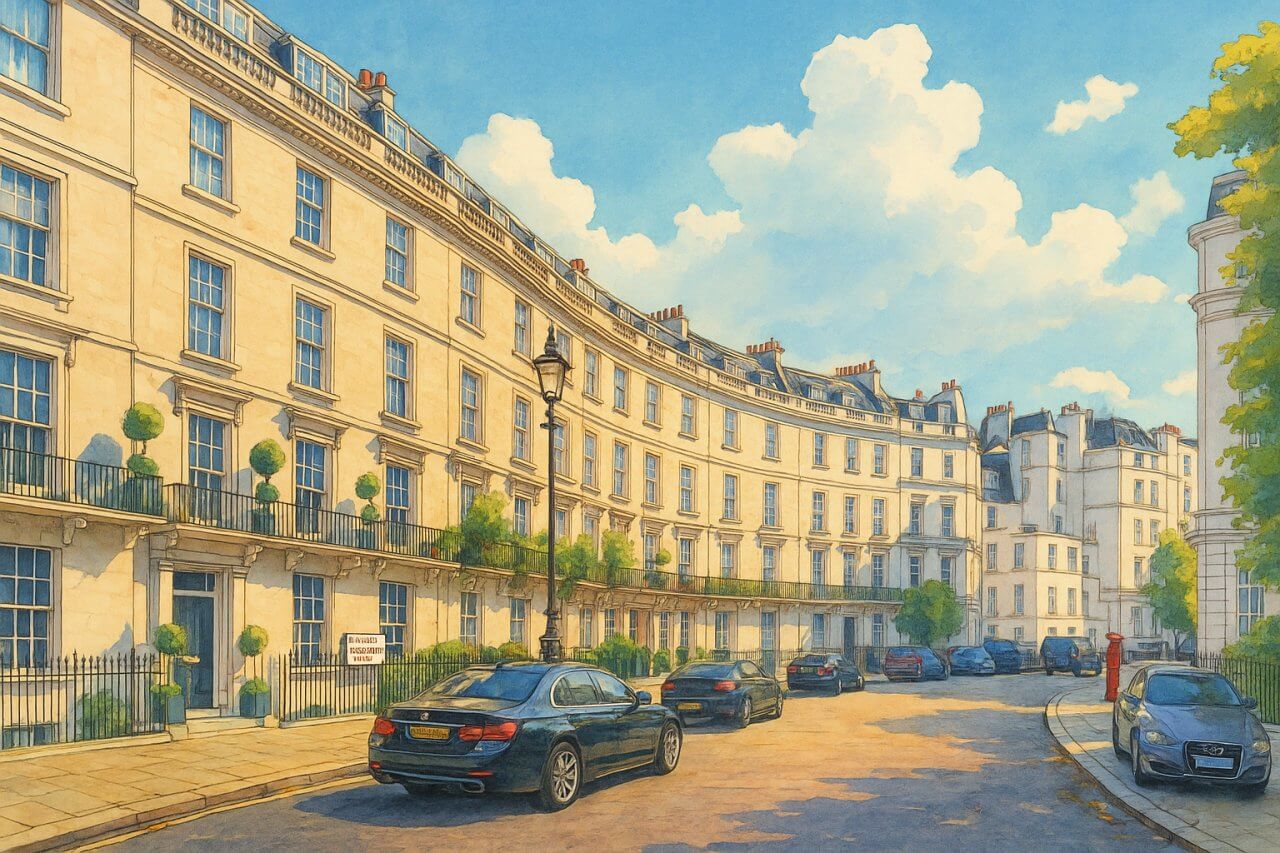
Wilton Crescent, London
Wilton Crescent is a graceful, curving street in the heart of Belgravia, one of London's most affluent and architecturally elegant districts. As its name suggests, the road forms a crescent shape, with an additional straight segment that connects the arc on both ends, giving it a distinct and picturesque layout.
Layout and Structure
The total length of Wilton Crescent is approximately 436 metres (1,430 feet). The street’s signature curve opens onto Wilton Terrace at the western end and Grosvenor Crescent at the eastern side. Branching out from the northern point of the arch is Wilton Place. Between these two entry points lies a short, straight connector that completes the street’s footprint. In the heart of the crescent is Wilton Crescent Park, a private communal garden available exclusively to the residents.
Wilton Crescent is a two-way residential street, though traffic is generally light, given the exclusive and tranquil nature of the Belgravia neighbourhood. Access is primarily for residents, service vehicles, and local traffic, helping preserve the area’s peaceful atmosphere.
Historical Background
Wilton Crescent was laid out in the 1820s as part of the grand vision of Thomas Cubitt and other developers working under the Grosvenor Estate. It was part of the broader expansion of Belgravia, which emerged as an elite residential area during the early 19th century, largely thanks to Cubitt’s consistent architectural planning and the area’s close proximity to Buckingham Palace.
Name and Pronunciation
The street takes its name from Wilton House, the ancestral home of the Earls of Pembroke, located in Wiltshire. The Earls were associated with the Grosvenor family through marriage, which is why the name was adopted in this prestigious part of London.
Wilton is pronounced WILL-t’n, with the phonetic transcription being /ˈwɪltən/. 
Character and Ambience
Wilton Crescent exemplifies the grand style of early 19th-century London architecture. Most of the houses on the crescent are stucco-fronted and span five or six storeys, including lower-ground and attic levels. Their white façades, black railings, and tall sash windows offer an enduring elegance. Many of the buildings have been converted into embassies, ambassadorial residences, and high-end apartments, although a number of full houses remain in private ownership.
The secluded crescent, set around a well-maintained garden, creates an air of refined exclusivity. Mature trees, iron lamp posts, and wrought-iron balconies add to the historic aesthetic that makes this street one of the most sought-after in the capital.
Streets connected to Wilton Crescent
Nearby Attractions and Landmarks
Wilton Crescent is ideally located for exploring some of London’s best-known sights:
- Hyde Park – Just a 10-minute walk to the north, this iconic green space offers boating, picnicking, and cycling.
- Belgrave Square – A short stroll west of Wilton Crescent, another gem of Belgravia, known for its embassies and gardens.
- Victoria Station – South of the crescent, with access to mainline rail, the Underground, and Gatwick Express services.
- Knightsbridge – East of the street, with its luxury shops including Harrods and Harvey Nichols.
Property and Real Estate
As of early 2025, property prices on Wilton Crescent remain among the highest in London. Full townhouses can sell for £15 million to over £30 million, depending on the extent of refurbishment and historical features. Luxury flats and embassy leases can also command similarly impressive figures.
Typical floor space for a full townhouse is around 7,000 to 10,000 sq ft (650 to 930 sq m), while individual apartments range between 1,500 and 3,000 sq ft (140 to 280 sq m). These sizes reflect not only luxury but the rarity of such properties in central London.
Transport Connections
The nearest London Underground stations are:
- Hyde Park Corner (Piccadilly line) – approximately 5 minutes’ walk.
- Knightsbridge (Piccadilly line) – about 10 minutes on foot.
- Victoria Station (Victoria, District, and Circle lines) – around 12 minutes’ walk, also offering National Rail services.
Nearby bus stops can be found on Grosvenor Crescent and Hyde Park Corner, with routes including:
- Bus 9 – Hammersmith to Aldwych
- Bus 14 – Putney to Russell Square
- Bus 19 – Battersea to Finsbury Park
Fun Fact
Wilton Crescent has long been associated with international diplomacy. Several embassies are based along the crescent, including those of Luxembourg and Liechtenstein. The area is also popular among foreign dignitaries and aristocrats for its discretion, architectural beauty, and proximity to central government offices in Westminster.
Quick Facts
- Location: Belgravia, City of Westminster
- Length: 436 metres (1,430 feet)
- Street layout: Crescent with a straight connecting segment
- Park: Wilton Crescent Park (private garden)
- Built: 1820s
- Name origin: Named after Wilton House, seat of the Earls of Pembroke
- Pronunciation: WILL-t’n (/ˈwɪltən/)
- Property value (2025): £15m–£30m for full homes
- Size of properties: Townhouses: 7,000–10,000 sq ft (650–930 sq m); Flats: 1,500–3,000 sq ft (140–280 sq m)
- Nearest Underground stations: Hyde Park Corner, Knightsbridge, Victoria
- Nearby bus stops: Grosvenor Crescent, Hyde Park Corner
- Nearby landmarks: Hyde Park, Belgrave Square, Victoria Station
- Fun fact: Home to several embassies and ambassadorial residences
Map of Wilton Crescent, London

Painting of Wilton Crescent, London (View image in full size)